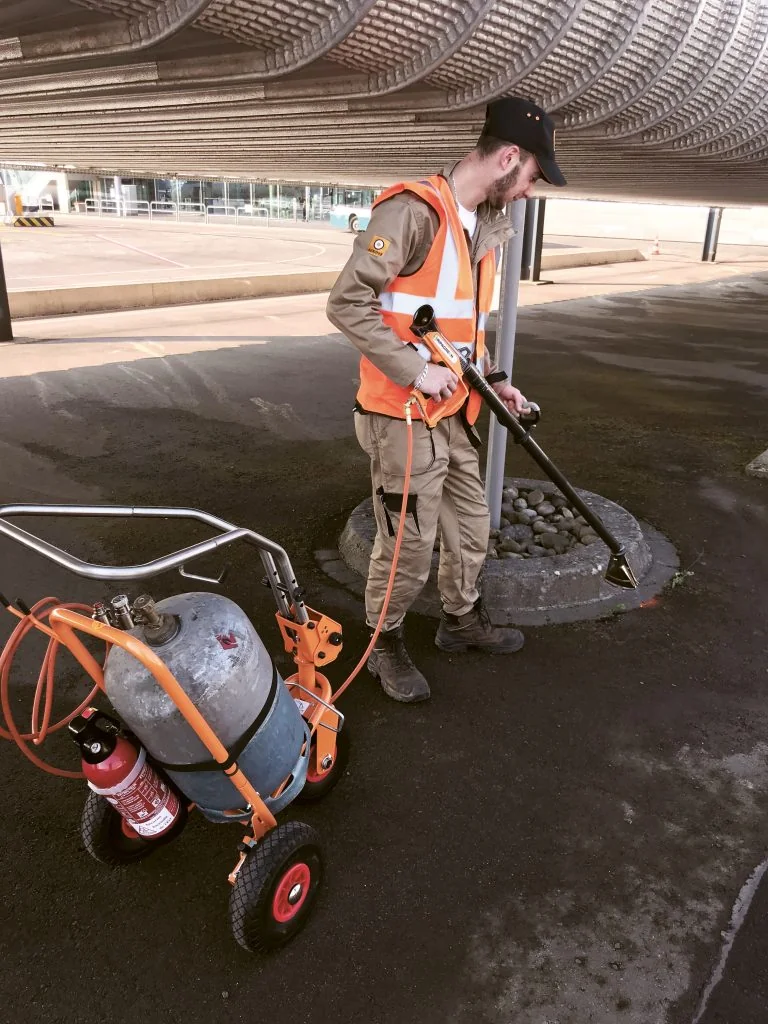Soil Management
Runway sanitation
| 2 | 50 | 155,000 M3 |
|---|---|---|
| YEARS OF WORK | DRILLING POINTS | OF REUSED SOIL |
Improved stability for more safety
As part of the runway renovation project, we need to remove the topsoil in order to stabilise the strips in accordance with eisa safety requirements.
The strip portion of a runway should extend a minimum of 75 m from the centreline of the runway and its extension. It should be prepared in a manner that minimises hazards arising from variations in the maximum load of the aircraft for which the runway is intended. The graded strip of the runway should be appropriately sloped to prevent the collapse of the aircraft’s nose gear. The surface must be prepared to provide adequate friction for the aircraft, and there should be sufficient load-bearing capacity beneath the surface to prevent damage. Aircraft manufacturers have determined that the maximum depth to which the nose gear can sink without collapsing is 15 cm. Therefore, the existing topsoil needs to be excavated, the sub-grade compacted, a suitable stabilising material added, and then the topsoil returned and seeded. Two preliminary soil analyses were conducted to determine the composition and quality of the soil.
Initially, a pre-analysis campaign was carried out on 10 borehole samples, which did not exceed the limits for Type A inert waste landfills. Subsequently, an additional campaign involving approximately 40 boreholes was conducted to validate these findings and assess the suitability of reusing the topsoil. Continuous analysis was carried out
throughout the project to ensure soil quality and an accredited company monitored the work. Any uncontaminated surplus arable land was then deposited on-site in an area authorised by the relevant authorities, thereby reducing the volume of traffic and congestion in the already saturated landfill sites. The designated area for material storage, vehicles, and waste was secured in compliance with the requirements of the Administration de la Gestion de l’Eau and the Administration de l’Environnement to mitigate the risk of soil contamination.
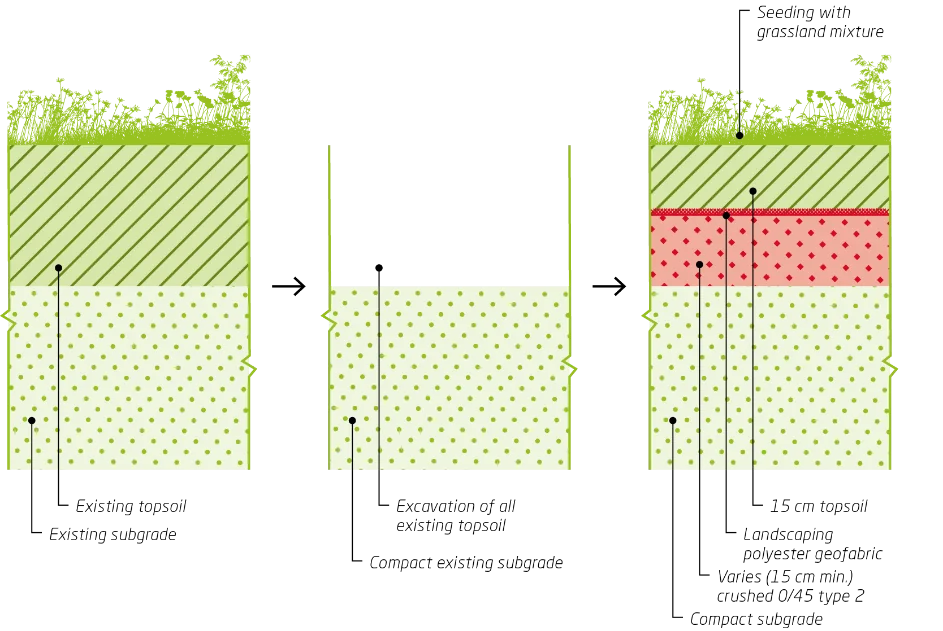
lux-Airport, in collaboration with the Administration de l’Environnement and the Administration de la Gestion de l’Eau, is developing a land use plan for different zones. This plan will facilitate the implementation of necessary anti-pollution measures to ensure a healthy environment and prevent contamination. Soil quality is analysed and restoration is undertaken for each project.
Cadastre of pollution risks
| 358 | 23 | 3 |
|---|---|---|
| HECTARE AREA | LAYERS | YEAR-LONG PROJECT |
The airport soil cadastre project is being carried out by lux-Airport with the support of the Administration de la Gestion de l’Eau (AGE) and the Administration de l’Environnement (AEV). The aim is to map the activities and equipment on the airport site that pose a risk to the soil and therefore to the groundwater accurately. We have gathered all the relevant information in order to create an evolving map of the airport site. The airport site is divided into several defined areas based on the POS Findel. These areas encompass potential pollution risks such as specific land usage, activities carried out in each area, historical data on embankments and activities, storage of hazardous substances, and the sewerage network. Additionally, the cadastre includes information on the natural environment, such as groundwater levels, protected areas, and vulnerable zones. It also incorporates other data like CASIPO, geotechnical studies, and rainfall analyses conducted on-site. In total, the database comprises over 23 layers. The next step involves conducting on-site inspections in order to identify all elements and potential risks. Thanks to the cooperation of various stakeholders at the airport, each building is visited to assess risks associated with the storage of hazardous products, installations, and activities that may lead to pollution incidents during abnormal operations. An evaluation grid, defined by AGE, will help to classify the risks and determine the necessary preventive and remediation measures.
All the collected data will be integrated into our Geographical Information System (GIS) database, which will be shared with all project stakeholders.
This comprehensive risk inventory tool will enable us to implement preventive measures and establish a remediation schedule for different areas based on their significance.
Hangar Nennig
As part of the refurbishment of the rain and wastewater treatment plant at Hangar Nennig, we discovered old buried oil tanks, which have already been neutralized and will be removed. The polluted soil has been removed in accordance with current regulations.
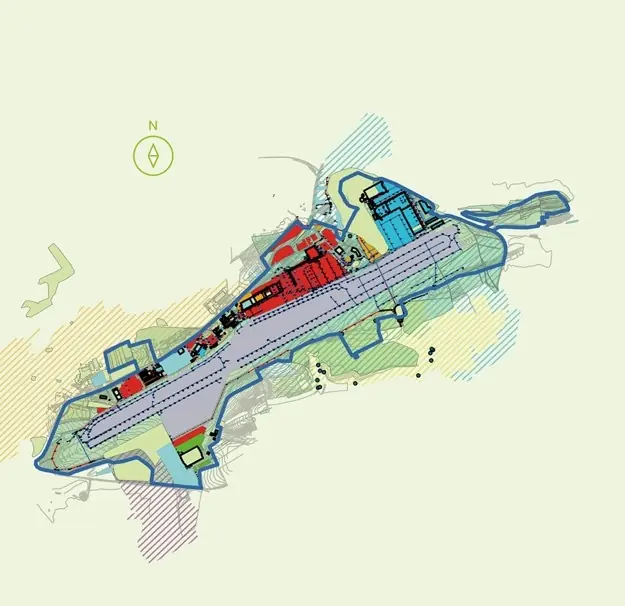
Biodiversity
Preservation, promotion and improvement
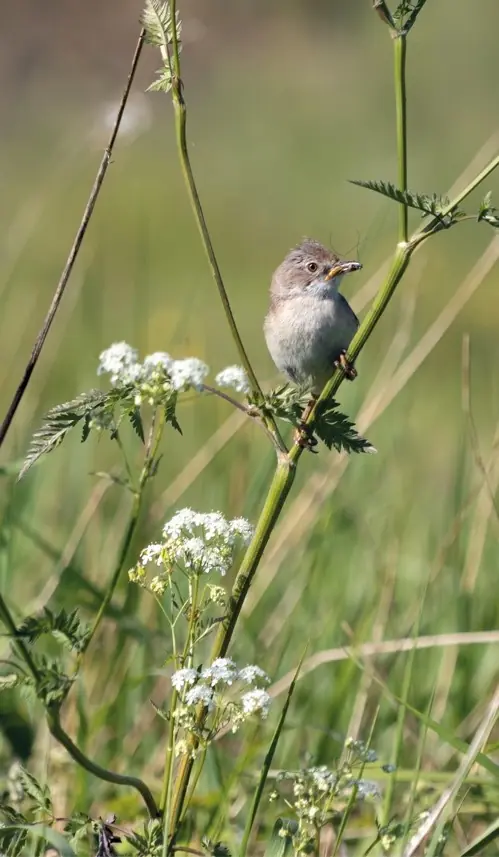
Fauna study
| 4 | 5 | 7 |
|---|---|---|
| SPECIES INVESTIGATED | FOREST STANDS | MONTHS OF INVESTIGATION |
In connection with the development of a green spaces management plan for the airport, we have conducted an airport fauna study. The study areas are located in the vicinity of Luxembourg Airport and are covered by forests that will have to be transformed in the near future because the increasing height of the woods will disturb the Obstacle Limitation Surface (OLS) of the airport. To ensure air traffic safety, the height of the groves must be reduced.
The overall investigation included the following species:

This study will help us to determine the impact of work required for airport safety reasons or new projects and to define the necessary measures to limit disturbance to wildlife. The study areas are located close to the NATURA 2000 sites “Grunewald” (FFH site LU0001022), “Vallée de la Syre de Moutfort à Roodt/Syre” (bird sanctuary – LU0002006) and “Région de Schuttrange, Canach, Lenningen et Gostingen” (bird sanctuary – LU0002018).
Breeding bird registration
The avifauna studies comprised five inspections including eyrie registration. A total of 52 breeding birds and 34 marginal settlers were found in all surveyed areas. The most common birds were the common whitethroat, yellowhammer, Eurasian skylark, tree pipit and common linnet but we also found red kite and northern goshawk.
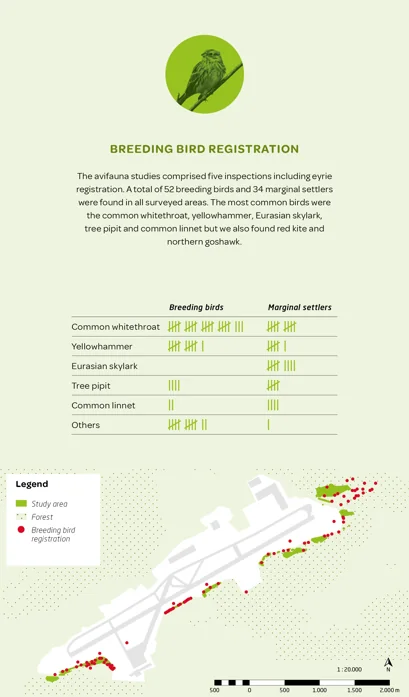
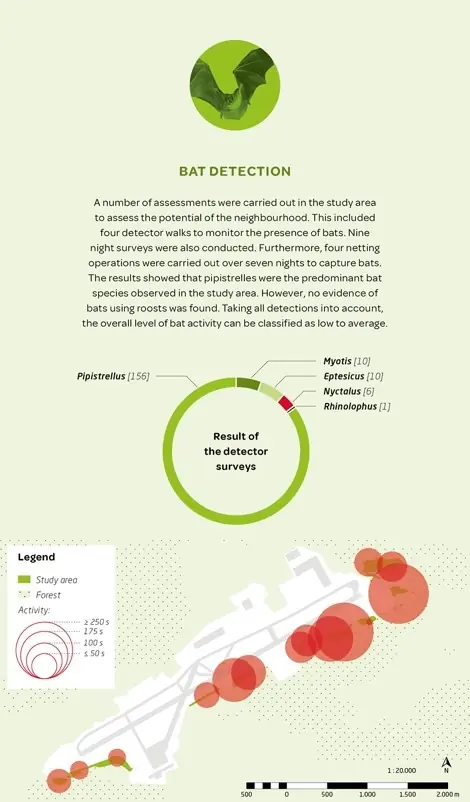
Bat detection
A number of assessments were carried out in the study area to assess the potential of the neighbourhood. This included four detector walks to monitor the presence of bats. Nine night surveys were also conducted. Furthermore, four netting operations were carried out over seven nights to capture bats. The results showed that pipistrelles were the predominant bat species observed in the study area. However, no evidence of bats using roosts was found. Taking all detections into account, the overall level of bat activity can be classified as low to average.
Dormouse registration
The study used a variety of methods to assess the presence of dormice. A total of 70 nest tubes were deployed at strategic locations. In addition, efforts were made to search for tracks and free nests to identify potential dormouse activity. Two dormouse sightings were recorded during the study, although no significant population was observed. Dormice are small nocturnal rodents, typically reaching a maximum height of 8 cm. They are generally widespread and reasonably common in Luxembourg. However, the main threat to dormice is the loss of their natural habitat due to the clearing of woods, hedges, copses or excessive pruning. This habitat destruction poses a significant risk to their population.
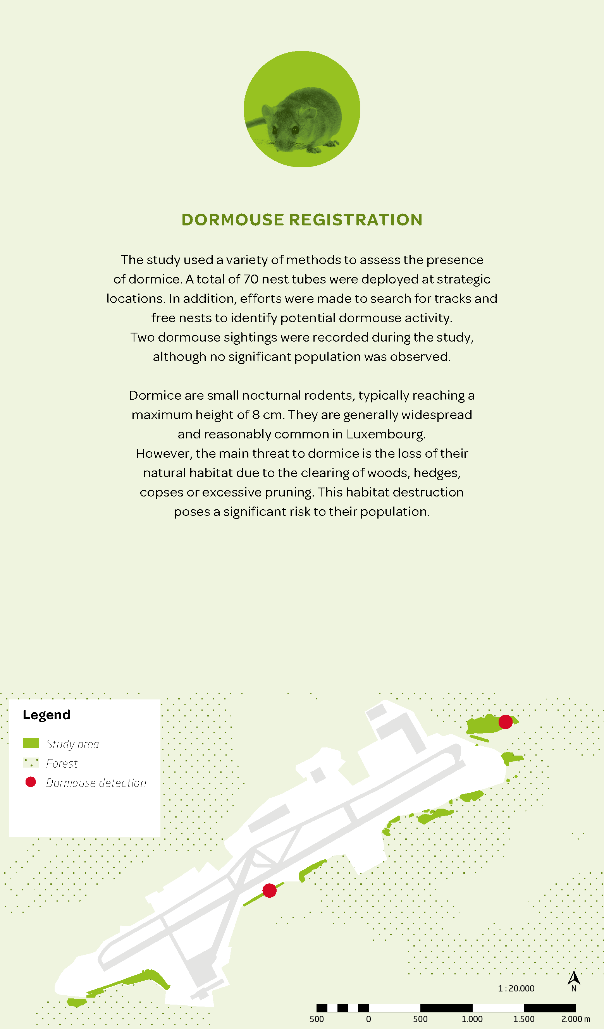
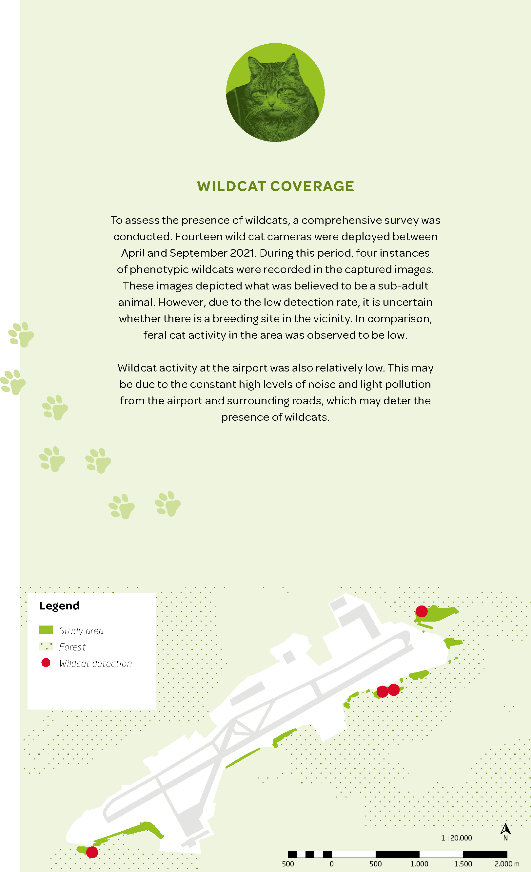
WildCat Coverage
To assess the presence of wildcats, a comprehensive survey was conducted. Fourteen wild cat cameras were deployed between April and September 2021. During this period, four instances of phenotypic wildcats were recorded in the captured images. These images depicted what was believed to be a sub-adult animal. However, due to the low detection rate, it is uncertain whether there is a breeding site in the vicinity. In comparison, feral cat activity in the area was observed to be low.
Wildcat activity at the airport was also relatively low. This may be due to the constant high levels of noise and light pollution from the airport and surrounding roads, which may deter the presence of wildcats.
Biodiversity
More bees at the airport
| 24 | 296 KG | 700 |
|---|---|---|
| BEEHIVES AT THE AIRPORT | HARVEST OF HONEY IN 2022 | HA BIO-MONITORING BY BEES |
Since 2019, in cooperation with the ANA, lux-Airport has set up 4 beehives located at antenna’s foot. This collaboration harvest 88 kg of honey in 2019, and 120 kg in 2020. 2021 was a less fruitful year, with a single harvest of 30 kg in summer due to unfavorable weather conditions: a winter not cold but very long and a not very hot, and very watery spring which resulted in not producing many flowers.
In 2022, Lux-Airport’s commitment to the preservation and development of bee populations takes on another dimension with the installation of 20 new hives. These hives are spread over two sites suitable for the tranquility and good development of bee populations. Ten new hives are located in a green space created in front of the new Cargolux Headquarter. This space is dedicated to biodiversity with benje hedges for birds, flowering meadows, cairns for reptiles, as well as insect hotels.
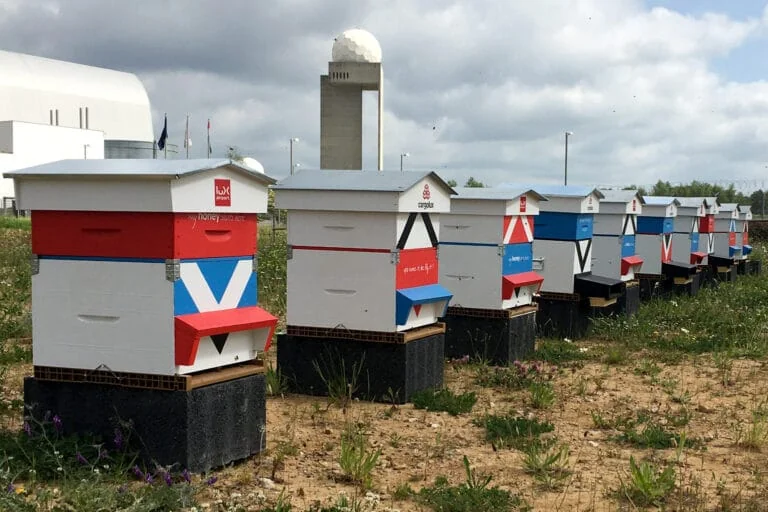
Ten other hives were installed in a green space set back from the track and close to the forest. The two new sites are each managed by a professional beekeeper:
- Un chalet pour les abeilles in the landside area
- Hunnegkescht in the airside area
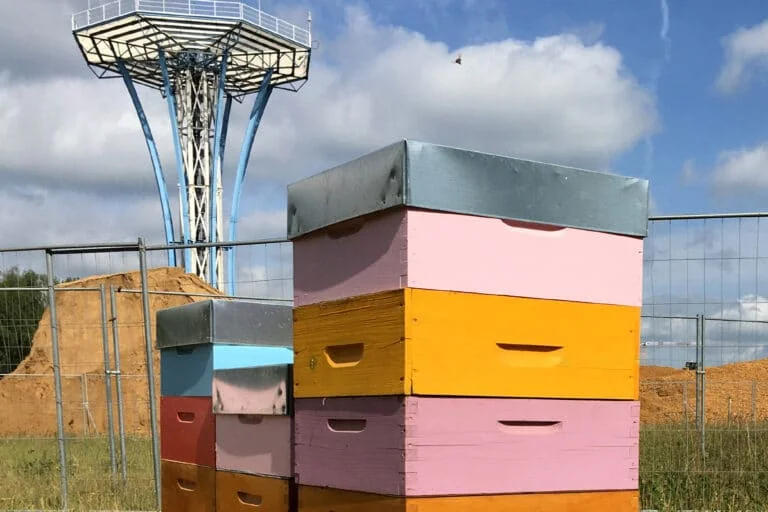

One of the hives will be "connected", i.e. it is equipped with sensors making it possible to know various parameters of the hive such as temperature, hygrometry, weight and rainfall, and thus not only to satisfy our curiosity but also and above all to ensure the good health of the bees.
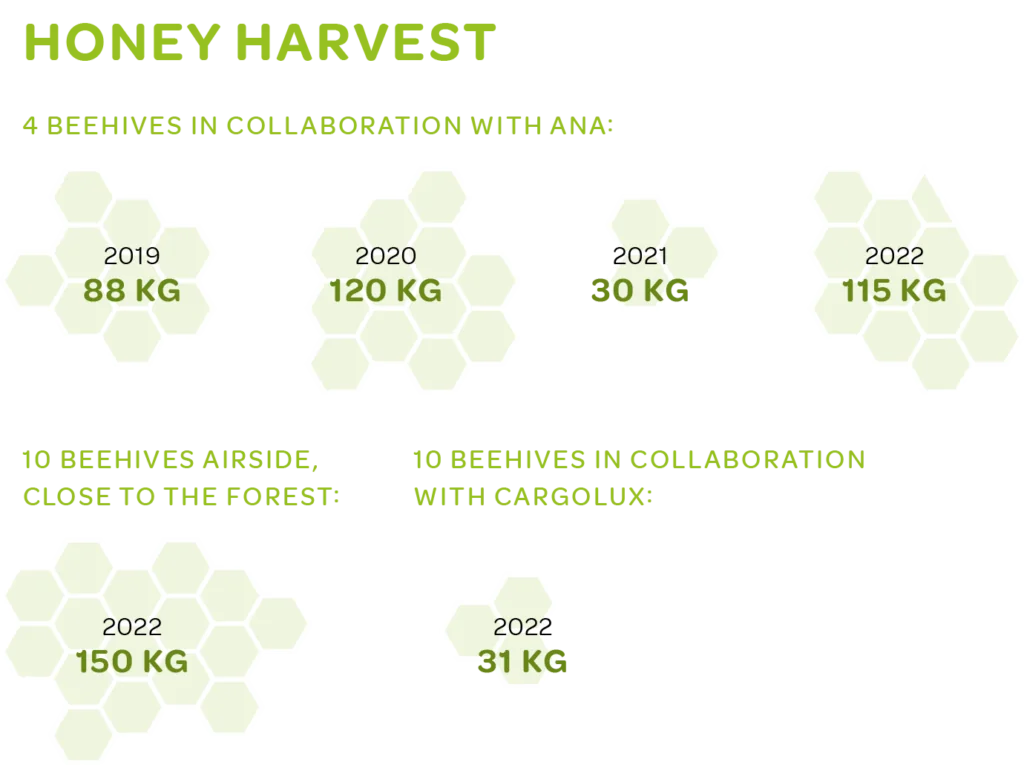
BEEOMONITORING
But the bees will not only participate in the development of biodiversity on the airport site, they will also help us to monitoring the air and soil quality in a radius of 2 km. Indeed, a bio-monitoring campaign using bee pollen has been set up with the company BeeOmonitoring.
Bees, as “natural drones”, collect pollen and nectar. The latter, used as bio-indicators, allow daily and continuous sampling via pollen’s traps installed on some hives. No less than 8 billion samples per year over 700 ha: no technology can reach this range!
These campaigns are conducted from April to October. Pollen samples of 100 to 200g are collected 4 times during the season. The pollen thus removed will not represent a shortage for the bees, because it is only 0.3% of their entire harvest.
Thanks to these natural sentinels, we will be able to analyze the presence or absence of no less than 25 pesticides as well as various pollutants, such as heavy metals, PAHs and PFAs. But this bio-monitoring also allows us to know the floristic diversity of the plants of the airport site, to analyze the risk presented by each species, to categorize the different habitats and to estimate the specific and periodic deficiencies of the fauna and its nutritional quality for the entire ecosystem.
The results of this bio-monitoring will then make it possible to measure the impact of our improvement actions, in particular the management of green spaces or rehabilitation projects, on local wildlife and the airport environment.
HONEY ANALYSIS
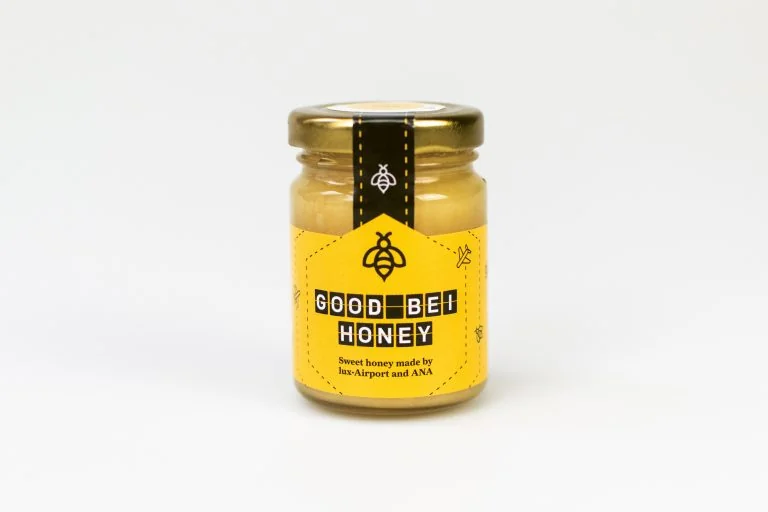
The appreciation of the quality of honey by the consumer is mainly achieved by the aroma. However, there are some measurable evaluation criteria for the honey’s quality:
HMF concentration
lux-Airport & ANA Honey spring & summer 2020: 1 mg / kg summer 2021: 1 mg / kg
HMF is a chemical compound resulting from the breakdown of fructose (sugar) and therefore a very good indicator of the degradation of honey. Starting from zero, its concentration will increase over time and with temperature. The HMF content therefore reflects the age and thermal history of honey. Natural honey, harvested without particular heating, contains no more than 5 mg of HMF per kg. During storage of honey (at room temperature), the HMF concentration can increase by approximately 5 to 10 mg / kg per year.
Honey must not have an HMF content greater than 80 mg / kg. This high figure is explained by the need to take into account all of the honeys produced worldwide (very high HMF contents for tropical honeys). In the European Union, the maximum level of HMF has been set at 40 mg / kg. However, these high rates are almost exclusively encountered in honeys coming from large packaging circuits. Honeys sold directly by beekeepers rarely exceed 10 mg / kg and almost never exceed 20 mg / kg.
Saccharase index or amylase / diastase
lux-Airport & ANA Honey spring 2020: 46,4 dz summer 2020: 32.4 dz summer 2021: 31.5 dz
Honey contains enzymes. Their quantities vary depending on the botanical origin of the honey and the intensity of the honey. The enzymes found in honey include sucrase (or invertase) and diastase (or amylase). They are very sensitive to heat and aging. They provide more precise information than the HMF on the thermal shocks the honey was exposed to. Diastase is more resistant to temperature than sucrase. These data provide information on the proper processing of honey and its freshness.
Moisture
lux-Airport & ANA Honey spring 2020: 16,8 % summer 2020: 16,2 % summer 2021: 16,3 %
Humidity is one of the most important characteristics of honey, because it plays a key role in its quality and preservation. It is involved in the viscosity, crystallization, flavor and fermentation of honey. Legal standards allow honey up to 20 percent, but only honeys with a moisture content below 18 percent keep well. Too dry (less than 16.5 percent), honey no longer releases its aromas optimally. It sticks in the mouth and dries all your saliva.
The water content of honey comes mainly from nectar but can be influenced by many factors, including harvest time, closure rate of the rays, storage conditions (before filling in jars), weather conditions and during of the harvest.
Sugars
lux-Airport & ANA Honey spring & summer 2019: 1,1 fructose / glucose index
Sugar analysis is important to confirm that honey has not been «adulterated» with cooking sugar (sucrose) – it can only contain tiny traces. Indeed, nectar or honeydew contains large amounts of sucrose. Bees should be given time to develop honey to transform it into fructose and glucose.
The fructose-glucose ratio makes it possible to evaluate the rate of crystallization. An F / G index below 1.05 will cause honey to crystallize often in less than a month. Between 1.06 and 1.45, it crystallize place between 2 and 12 months. An F / G index greater than 1.45 means that the honey will remain liquid for at least one year.
As part of the analysis, the sample complies with the legal provisions of the current version of the honey ordinance for table honey. In addition to these «normal» honey quality analyses, we decided to also analyze the presence of heavy metals in honey. No measurable trace was detected.
BEES AND PLANES … A SECURITY PROBLEM?
There is little operational concern about bees interacting with aircraft: if bee and jet meet, the bee will lose. But there have been recent swarming incidents – a natural occurrence when a second queen leaves the hive in search of a new home and around half the hive’s bees follow.
In one incident, a whole swarm of bees chose to nestle in an airplane engine in South Africa. Their arrival paralyzed airport operations, and experts had to be called to safely remove the swarm from the engine. But here in Luxembourg, the risk of this happening is minimal because there are only bee farms in the immediate vicinity and our beekeepers control the swarming of their hives.
THE WORK OF THE BEEKEEPER
A new occupational area at lux-Airport: the beekeeper works from March to September. When he goes to check the swarms and their broods, he calms the bees with wood smoke. After opening the hive, he delicately removes the frames and, with a trained eye, identifies whether everything is fine or if the hive needs some help.
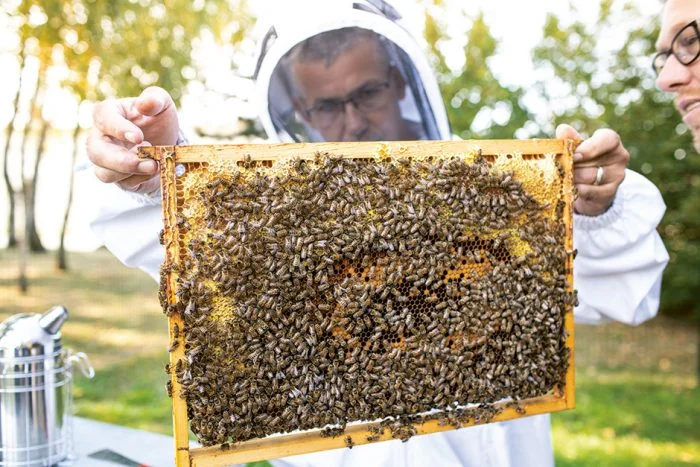
A beekeeper’s material consists of a suitable outfit to prevent the curious bee from entering sleeves or pockets and becoming trapped, which can often result in a sting. A bee smoker to calm them is also required to open the hive and leave the frames in peace. The reward for his careful watch and care: sweet golden honey.
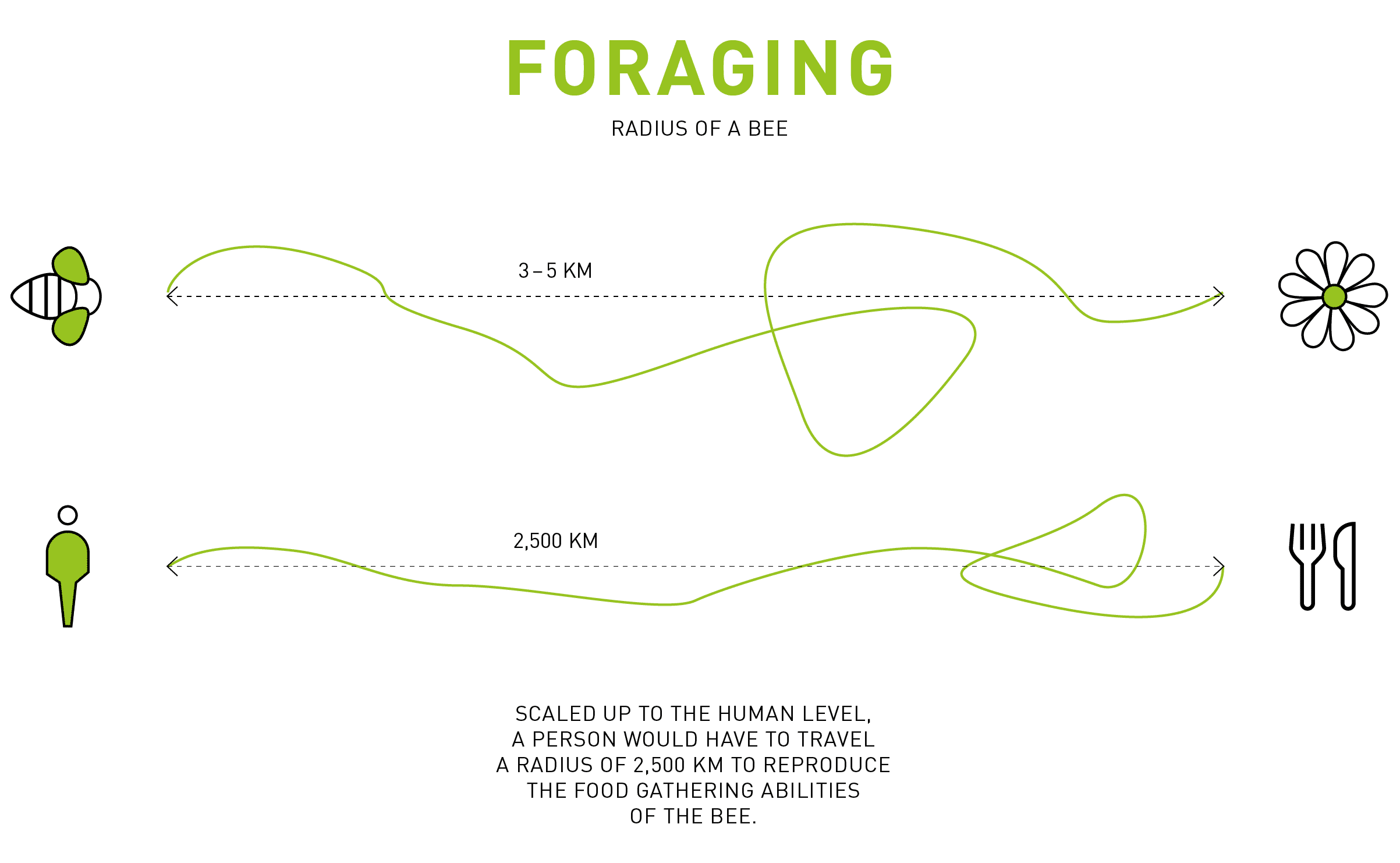
02 / STOP GLYPHOSATE
WEEDS NEED TO BE KEPT IN CHECK ON THE AIRPORT. THE HUNT FOR AN ALTERNATIVE TO CONVENTIONAL WEED KILLERS LED TO A SIMPLE SOLUTION: HEAT
The principle of the thermal weeder is to create a thermal shock of 1,400°C for a fraction of a second on the aerial surface of the plant. The aim is not to burn the weed per se, but to give it a momentary blast of heat such that, within 2 days, the plant dries out and dies. This is a practical and ecological solution because no chemicals are used during weeding.
In 2016 Ripagreen® won the Grand Prize for innovation in the «sustainable development» category at Salon Vert, the largest exhibition in France for green spaces and landscapes. The Ripagreen kit and its unique heat diffuser system were held in high regard by the jury. This method consumes less energy, is faster and more effective. To be perfectly effective however, it requires a great knowledge of weed varieties, their resistance and their life cycle.
